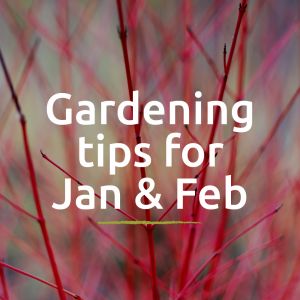Gardening Jobs for January and February
It’s almost the season to get sowing!
As the days get longer and the weather gets milder, we can start to plan and think about what to plant, where and when.
Early sowing is already taking place, but over the next few months this will steadily increase as it gets warmer and we welcome spring with open arms.
January and February are transition months - a time to plan and prepare and get ready for the busier spring and summer months.
You may have already planned your garden rotation and looked at what plants, shrubs and crops to grow this season, but if not there is still plenty of time and plenty of wintry weather to keep us indoors for a little while longer.
Preparation will be key over the coming weeks and will ensure gardens are tip-top come the new growing season.
Soil & Compost
- Preparing soil is the foundation of a good growing season. Many nutrients are lost during the growing months as different plants need different things from the soil. However, the soil does need to start getting warmer before preparation begins, so if the ground is too hard, you may need to wait a while longer.
- During a mild spell, add a good organic soil conditioner and feed such as 6X Natural Plant Feed. This will revitalise the soil and give it a nutrient boost.
- If your soil is heavy or clay-based, add grit to improve drainage and Clay Breaker to cut through the heaviness and help condition the soil for spring without changing the soil’s natural pH.
- A compost bin is a great addition to any garden. If you already use a compost bin, turn over the contents to aerate. To speed up the composting process add Compost Maker as this will accelerate the decomposition process, producing a rich, dark compost.
- Soil can be very wet or water-logged at this time of year. Use boards to navigate across the soil until it firms up. It will help the soil’s structure and keep your wellies mud-free!
Flowers, shrubs and fruit trees
- If you received an amaryllis plant for Christmas, plant and place on a warm windowsill. These can grow quite tall, so make sure you have plenty of room!
- Trim back ivy and other climbers that have outgrown their space. Check wisteria. If already pruned, look for side shoots and cut back.
- Cut back deciduous, ornamental grasses.
- Late-summer flowering clematis can now be pruned to around 30cm in height from the base.
- Continue to deadhead winter flowers such as pansies.
- As we move into February, lily bulbs can be planted in pots and grown indoors in preparation for summer.
- Over-wintered dahlia tubers can now be started into growth. Check for mould and remove tubers with disease. Place healthy tubers in a light, warm spot but be careful not to dry them out.
- Check stored fruit for rot and remove to prevent spread to healthy fruit.
- Protect early blossom on fruit trees from frost by using fleece or similar covering to keep the chill away.
- If you still have winter flowers in bloom, check to ensure they are not covered in leaves or debris. If so, clear the ground.
- Grape vines, apple and pear trees are now also ready for pruning.
- Plant bare root roses and prune hardy evergreen hedges.
- Ensure all houseplants are kept hydrated. Many of us have the heating on for long periods of time which will dry out plants, especially those on sills near to radiators. Most houseplants can be fed with Organic All Purpose Plant Food, or try House Plant Feed or if you have orchids in bloom, an Orchid Bloom Feed.
- Check for pests! Fruit trees are susceptible to pest infestation, so regularly check for insect or aphid eggs. Remove insect debris with a tree wash, such as Vitax Winter Tree Wash. Make sure the conditions are dry before applying.
- Once clean, use tree bands to prevent crawling insects.
Vegetable crops
- Check for weeds. They will start to creep back now the days are getting longer. Remove as soon as they appear and it will be easier to manage as the season progresses.
- Harvest any winter vegetables such as parsnips, leeks and brussel sprouts.
- Start to prepare the ground for early peas.
- Chit potato tubers to allow them to start sprouting.
- Seeds can now start to be sown indoors in readiness for planting out. Cucumber, tomatoes and peas can all be planted in seed trays.
- As we move into February, broad beans, carrots and summer cabbages can be grown outside under cloches, but check the soil condition first as they will not grow well in water-logged, or sodden soil.
- Sow winter salads in the greenhouse or conservatory.
Cleaning
- Although winter is a time we see fewer pests, warm conditions will see them thrive. Continue to clean greenhouse tools with Greenhouse Disinfectant and use it to wipe down surfaces after use.
- If you have not already, look through your seed packets and discard any that are starting to rot or sprout. Remove out of date seeds too.
- Maintain cleaning of bird baths and bird feeders.
January and February are ideal for preparing for the season to come, but the weather is unpredictable. If you are unable to spend time in the garden, then it can wait until it is warmer. There are still plenty of jobs to do indoors from cleaning tools to choosing new seeds and plants.
Your login details have been used by another user or machine. Login details can only be used once at any one time so you have therefore automatically been logged out. Please contact your sites administrator if you believe this other user or machine has unauthorised access.














